|
AUSTRALIAN
NAVY FOUNDATION DAY "CRESWELL ORATION"
Inaugural Address by Commodore Jim Dickson MBE AM RAN Ret'd 14
September 2001
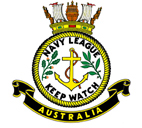 (c)
Copyright J. Dickson AM September 2001 (c)
Copyright J. Dickson AM September 2001
In the next 20 minutes I will endeavour to give you a summary
of what took place in terms of Australian naval development between
1901 and 1911, identify the key players and briefly speculate
on how it has come about that we have distorted the story of Australia's
naval history.
In the circumstances we enjoy today it is very difficult for us
to picture life in Melbourne in 1901 when federation came about.
My mother was born in 1900 in Beechworth with an eye defect, and
from the age of 3 or 4 she had to come to Melbourne every few
months for treatment. Her siblings envied her and when she returned
home a couple of days later they all wanted to know how many cars
she had seen. Compare that with today and it will give you some
sense of perspective on the magnitude of the change whic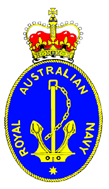 h
has taken place in relation to matters maritime of similar magnitude. h
has taken place in relation to matters maritime of similar magnitude.
The sea was this fledgling nation's link with the rest of the
world; its highway for trade and commerce; its medium for transporting
commodities, materials, produce, mail, passengers and cargo between
ports within Australia and overseas; its major communication line,
and its protective ring. One hundred years of extraordinary progress,
development and invention including air travel and transport,
computers, satellites and an explosion in communications and weaponry
have seen alternative means introduced for many of these vital
functions - but it is salutary and prudent to be mindful that
even today 96% of our trade is still transported by sea.
Because the sea was such a lifeline for the nation a century ago,
the maritime environment was far better known and understood than
it is today and the navy, its guardian and protector, was appreciated,
respected and supported in a way it is hard for Australians of
today to realise. The sea was the key to international power and
influence. In 1901 it was not in dispute that Britannia ruled
the waves and it was that fact, and the authority and capability
of the Royal Navy which had enabled Britain to reach out, find
, develop, nurture and exploit the potential of the British Empire.
The gold rush, which had seen Melbourne grow from humble beginnings
in 1835 to the nation's principal centre, de facto political capital
and focus for immigration, inevitably attracted elements who were
keen to avail themselves of any opportunity to relieve shipping
of some of the precious cargo it transported to different parts
of the globe.
Port Phillip was busy not only with traders and commercial vessels
but also with scores of vessels bringing settlers and prospectors.
That is why Victoria had the biggest navy comprising 6 ships,
the major unit being HMVS Cerberus, an iron-clad monitor, the
hulk of which now resides as a breakwater at black rock. How it
acquired some of these vessels - and their history - is a fascinating
story in itself but not one John Wilkins bade me to include today.
Notwithstanding the paucity of men-o-war, the navy was the primary
instrument of defence, a fact recognised by both the populace
and, importantly, by those who wielded the power-the politicians.
(how times have changed.).
So, what did Australia have by way of maritime defence assets
in 1901?
Not much.
New South Wales had 2 decrepit second class torpedo boats. Victoria
had the Cerberus and 5 torpedo boats. South Australia had the
cruiser protector and 1 torpedo boat. Queensland had 2 gun boats,
1 torpedo boat and a picket boat. This was not really surprising.
From the earliest days of settlement Britain had accepted responsibility
for safeguarding the nation's (and thus the British empire's)
interests. The colonial states viewed this with different perspectives
and some states, particularly Victoria, saw the need to make provision
for their own maritime forces which could cope with a localised
contingency.
Our founding fathers were very mindful of their responsibilities
concerning defence.
On 1st March 1901, only 2 months after the proclamation of federation
the Australian Commonwealth Defence Act was passed, transferring
the several colonial naval forces and establishments to the commonwealth.
For practical reasons the states were permitted to administer
the units of the new commonwealth naval force under the previous
colonial state acts and regulations up until february1904 when
the commonwealth was ready to assume full control.
Commonwealth Navy Headquarters were established in Melbourne and
remained here for 61 years. There are some in this audience who
would be aware of this fact, but outside here I doubt that 1%
of the population would know it.
It was partly because Melbourne was Australia's defence headquarters
that this city developed such an affection for the military establishment
overall. For the navy this was particularly so. Visits by fleet
units were frequent and welcome, the reserve prospered, navy uniforms
were seen at all manner of ceremonies and functions and a close
affinity grew between the public and the navy.
This had its spin-off in support for the navy and impact on recruiting
and no-one will ever convince me that the move to Canberra, the
closure of HMAS Lonsdale, the abandonment of the Melbourne Port
Division have not had a very adverse impact on the navy's public
image and its attractiveness to the people of Melbourne.
However, that is another hobby-horse that I won't ride today.
 Prime
Minister Edmund Barton selected the Australian national flag on
3rd September 1901. Until this time, vessels of the commonwealth
naval forces had flown the naval blue ensign. The ANF was used
as the Ensign from 1901 till 1911, when the Royal Charter was
granted and permission given to fly the UK white ensign. This
situation continued till 1st March 1967. Prime
Minister Edmund Barton selected the Australian national flag on
3rd September 1901. Until this time, vessels of the commonwealth
naval forces had flown the naval blue ensign. The ANF was used
as the Ensign from 1901 till 1911, when the Royal Charter was
granted and permission given to fly the UK white ensign. This
situation continued till 1st March 1967.
It was not long before differences in attitude began to emerge
between the federal parliament and Great Britain over the direction
naval affairs should take.
The 1902 colonial conference agreed that 2 Royal Navy cruisers,
HMS Challenger and HMS Psyche, would be manned exclusively by
Australians under RN command. My interpretation from readings
of the history of this period is that Britain was keen to retain
control and was happy as long as Australia developed a navy which
was a microcosm of the RN, whereas even in these early days, there
were those here who wanted Australia to develop an independent
stance. In British eyes Australian branches of the Royal Naval
Reserve (RNR) should be formed. Recruits to the permanent force
would do their new entry training in HMS Psyche and their advanced
training in HMS Challenger before being drafted to ships of the
Commonwealth Naval Forces.
The Commonwealth Defence Act 1903, amending that of 1901, came
into operation on 1st march 1904. From this date Australian commonwealth
naval forces were administered by the commonwealth collectively.
In 1904 the states various naval brigades were disbanded and a
commonwealth naval forces militia, the forerunner of the RAN Reserve,
was born.
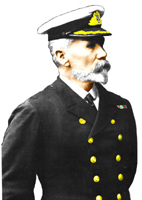 In
1905 the 1903 Defence Act was further amended to establish an
Australian naval board of administration with Captain W.R. Creswell
as director. This board provided centralised command and control
of the 12 ageing Australian naval force vessels acquired from
the colonies immediately after federation. The original 14 had
been reduced by 2 as New South Wales' torpedo boats were found
to be in such poor condition that they had been sold off. In
1905 the 1903 Defence Act was further amended to establish an
Australian naval board of administration with Captain W.R. Creswell
as director. This board provided centralised command and control
of the 12 ageing Australian naval force vessels acquired from
the colonies immediately after federation. The original 14 had
been reduced by 2 as New South Wales' torpedo boats were found
to be in such poor condition that they had been sold off.
Captain Creswell from the outset proved a forceful director. He
proposed a local squadron of three 3000 ton cruiser/destroyers,
16 destroyers and 13 torpedo boats within 5 years, plus the manufacture
of the necessary munitions in Australia. (I like his style!) The
Australian government referred the Creswell proposals to the imperial
committee on defence, who received them less than warmly. Captain
Creswell was not assisted by the division of opinion apparent
within Australia. Some politicians of vision, notably Alfred Deakin
and Andrew Fisher, supported Creswell in his desire to establish
a naval force independent of the royal navy and able to safeguard
the Commonwealth's interests in its own right. Others were happy
to leave the responsibility to the Royal Navy and see the Commonwealth's
meagre economic resources used for the development of matters
other than defence.
It is interesting to note that New South Wales, which had always
enjoyed protection from the Royal Navy, was very happy to continue
to rely on the mother navy.
After a frustrating and fairly fruitless visit to England in 1906
Captain Creswell returned to Australia and in 1907 submitted revised
proposals for a flotilla of 9 first class torpedo boats and 6
submarines. Even this he could not get the Australian government
to agree upon although Prime  Minister
Deakin (left blue portrait) put aside sufficient funds to build
the boats if and when parliament finally agreed. Minister
Deakin (left blue portrait) put aside sufficient funds to build
the boats if and when parliament finally agreed.
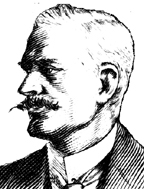 In
1908 Andrew Fisher (right black portrait) replaced Alfred Deakin
as Prime Minister. Notwithstanding Deakin's provision of money
for the building of torpedo boats, Fisher ordered 2 Australian
destroyers from British ship yards. In
1908 Andrew Fisher (right black portrait) replaced Alfred Deakin
as Prime Minister. Notwithstanding Deakin's provision of money
for the building of torpedo boats, Fisher ordered 2 Australian
destroyers from British ship yards.
Captain Creswell proceeded with administrative and organisational
arrangements to set the Australian Navy on a firm footing: like
his successors down the line he needed the hardware to go with
them.
1908 was the year in which the US Great White Fleet visited Melbourne.
Reports filtering back later made clear the concern America felt
about Australia's state of maritime defence in regard to both
material and the nation's almost total dependence on the Royal
Navy.
By 1910 Andrew Fisher had come round to supporting Creswell's
modified proposals of 1906 which recommended 19 destroyers. Construction
commenced immediately using some of the money that Alfred Deakin,
when Prime Minister, had set aside. In this year the first 2 destroyers
built in England, Commonwealth Naval ships, CNS Parramatta and
Yarra, arrived in Australia.
 In
the following year His Majesty King George V consented to a submission
proposing that the naval forces of the dominions of Canada and
Australia should have the prefix Royal attached to the official
title of their forces and from this time onwards the force became
known as the Royal Australian Navy (RAN) and the vessels known
as Her Majesty's Australian ships (HMAS). In
the following year His Majesty King George V consented to a submission
proposing that the naval forces of the dominions of Canada and
Australia should have the prefix Royal attached to the official
title of their forces and from this time onwards the force became
known as the Royal Australian Navy (RAN) and the vessels known
as Her Majesty's Australian ships (HMAS).
In the same year a universal training scheme was adopted calling
for elementary training for boys under military age followed by
some years of intensive training as adult members of a citizens
naval or army reserve.
 Commonwealth
Navy Office was established in Lonsdale St., opposite the law
courts in 1911, a four member Australian Commonwealth Naval Board
(ACNB) appointed, and after a decade of difficult groundwork,
the navy gathered steam and started to really make headway. Commonwealth
Navy Office was established in Lonsdale St., opposite the law
courts in 1911, a four member Australian Commonwealth Naval Board
(ACNB) appointed, and after a decade of difficult groundwork,
the navy gathered steam and started to really make headway.
The now Rear Admiral Creswell was appointed First Naval Member,
a position he was to hold for the next 8 years; the 'recommendations
' of Admiral Henderson RN, sent out from UK to advise on the strategic
infrastructure needed for development of the ran, were acted upon;
and the first steps were taken to establish a royal Australian
Naval College. The imperative for action on matters of defence
was emphasised by mounting concerns over the situation in Europe
where tension between Britain and Germany was increasingly apparent,
and uncertainty over the intentions of Japan.
That Australia moved with increased momentum from 1911 onwards
proved very fortuitous - but it in no way justifies the fact that
the years of frustrating endeavour between 1901 and 1911 have
been virtually banished from the nation's naval history.
The birth and infancy of the nation's navy and the military forces
required input 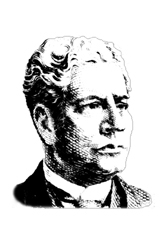 from
many. Men like Edmund Barton (top portrait), John Forrest, George
Reid (lower portrait) and Walter Thring (the latter a Royal
Navy officer of brilliant potential who was cast aside when Jackie
Fisher became first sea lord), all, at times, made contributions
of note, but in my view three men stand out clearly as men of
vision - two of them influential political figures and one a naval
officer. from
many. Men like Edmund Barton (top portrait), John Forrest, George
Reid (lower portrait) and Walter Thring (the latter a Royal
Navy officer of brilliant potential who was cast aside when Jackie
Fisher became first sea lord), all, at times, made contributions
of note, but in my view three men stand out clearly as men of
vision - two of them influential political figures and one a naval
officer.
Alfred Deakin and Andrew Fisher, Prime Ministers several times
in the first decade of the Commonwealth, were both very strong
advocates of the development of an independent national defence
capability (i.e. what we now call self-reliance). They differed
in terms of what they saw as the desirable composition of an Australian
Defence Force, but they shared the same strategic concept, displayed
a sound understanding of the need for strong 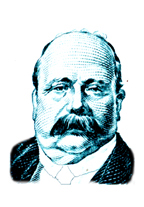 maritime
defence, and it seems to me to be a pity that many of their successors
have had a lesser understanding of the importance of building
and maintaining naval forces capable not only of defending our
trade links and sea lines of communication but capable at the
same time of exerting powerful influence in support of our foreign
policy. maritime
defence, and it seems to me to be a pity that many of their successors
have had a lesser understanding of the importance of building
and maintaining naval forces capable not only of defending our
trade links and sea lines of communication but capable at the
same time of exerting powerful influence in support of our foreign
policy.
William Rooke Creswell, the third of the trio, must have been
a remarkable man. After a promising start to his career in the
RN, where he did quite well for himself financially through 'bounty
money', he left for medical reasons and migrated to Australia
in 1879. At the time of federation he was Naval Commandant in
Queensland and as early as 1899 he had gone on record advocating
the centralising of the States' Naval Brigades under a national
authority. He grew in influence and gave frequent voice to his
opinions in the early years of federation, and this led to him
being appointed in 1905 as the first director of the Australian
Naval Board of Administration.
From this point on he exerted steadily growing influence on all
aspect of the development and growth of the fledgling navy, and
one can only look back with awe and amazement that one man could
survive for 14 years the innumerable changes of political masters
and the bureaucratic in-fighting which must have attended the
nation's early years as the competing factions jostled for a share
of the meagre resources available. Not only did he survive, he
achieved, and by the time he retired in 1919 after 8 years as
the royal Australian Navy's first chief of naval staff he had
set the navy on a very firm course.
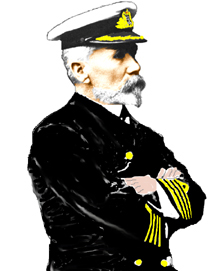 Photos
and images of Rear Admiral Creswell portray him as severe and
autocratic, about as happy looking as W.G. Grace when 'given
out for a duck', but Australia owes a great deal to this man
who has been seriously under-celebrated by the service to which
he gave so much. Photos
and images of Rear Admiral Creswell portray him as severe and
autocratic, about as happy looking as W.G. Grace when 'given
out for a duck', but Australia owes a great deal to this man
who has been seriously under-celebrated by the service to which
he gave so much.
It can hardly be regarded as surprising if Australians do not
generally know that their navy is 100 years old this year. For
the service has been less than vigorous in making this fact known
and I think it is likely that many of those interested in such
matters see this year as its 90th birthday.
How and why has this come about? I suggest there are several reasons.
First, the "silent service" syndrome was a very real factor
in days gone by. The navy took an almost perverse pride in keeping
silent, letting its deeds and people outside the service extol
and advertise it and make known its virtues. It has shed this
custom now, and in a PR driven, materialistic world it is up there
with the rest, promoting itself, communicating what it does, explaining
how it operates and selling itself to the community it serves.
It has to: if it doesn't, it runs the danger of being submarine-like
and disappearing.
Secondly, to such an extent was the Australian Navy the
child of the royal navy that it aped its parent unbelievably for
the first half of last century - well into the 1950's. In uniforms,
administrative practices, operational procedures and across the
whole spectrum of naval activity it was almost an exact replica
of its mother service. There was very little singularly Australian
about it before 1911. Believe it or not, this extended even to
the curriculum at the RANC where those of who went through that
institution as 13 year old entries grew up learning naval history
not of the sinking of the Emden or HMAS Sydney's glorious action
against the Bartolomeo Colleoni or the battle of coral sea or
the action in Leyte Gulf, but rather of Nelson's victories in
the battles of Trafalgar, the Nile and Copenhagen. As a teenager
in those days one did not query or question the judgement of one's
superiors in such matters: It is only when one grows up and realises
the opportunities missed that one reflects on how idiotic it all
was.
Thirdly, by the last quarter of the 20th century, with
no WW11 or Korea or confrontation or Vietnam war to keep the services
in the spotlight and with the well intentioned "peaceniks" starting
to influence public attitudes and incline a generation against
support for the defence force, there was a need to take opportunity
to gather publicity wherever one could. This was one factor which
led to the concept of the fleet review in Sydney Harbour in 1986,
billed and put before the public as the 75th anniversary for the
ran. Technically, it was correct in that it was 75 years since
the title royal was conferred on the Australian Navy and it was
a spectacular occasion which few who saw it will ever forget.
Regrettably, however, it had the effect of instilling in the public
mind the belief that the Australian Navy was born in 1911.
There are many other reasons but time constrains me to limiting
my observations to these three principal ones. This belief that
the Australian Navy's history began in 1911, as well as being
inaccurate and misleading, is in my view an insult to those who
laid the foundations of the service from 1901 through 1910 and
fought the bureaucratic battles which enabled the service to play
the significant part it did in world war 1, which broke out so
soon thereafter.
 Of
the navy's effort in that conflict, Billy Hughes (see portrait
left) , the then Prime Minister, was to say that "but for the
navy, the great cities of Australia would have been reduced to
ruins, coastwise shipping sunk and communications with the outside
world cut off". Of
the navy's effort in that conflict, Billy Hughes (see portrait
left) , the then Prime Minister, was to say that "but for the
navy, the great cities of Australia would have been reduced to
ruins, coastwise shipping sunk and communications with the outside
world cut off".
These were fitting and appropriate words to draw the public's
attention to the contribution the navy made to the 'Great War'.
Though the navy continued to make a major contribution through
the rest of the first 100 years of federation it is difficult
to find other acknowledgments as generous as Billy Hughes'.
What can be done to set the record straight?
The answer begins with those of us here. we must take every opportunity
to right this wrong and to encourage recognition of the fact that
the Australian Navy's true birth date was the same as the army's
- 1st March 1901.
The army is under no illusion - it is proudly celebrating its
centenary this year and we should be doing the same.
In the fullness of time, constitutional change may have an influence.
For I see it as inevitable that Australia will become a republic
in due course and, when we do, the prefix "royal' will inevitably
disappear. Whether that is before 2011 - one hundred years on
from the conferring of that prefix - remains to be seen. I hope
I am there to find out as I hope all of you here in this room
today will also be.
Meanwhile, I congratulate John Wilkins and the Navy League on
achieving what they have today.
Next month in Sydney many Naval personnel past and present will
gather for a programme of activities which includes a fleet review
by the Duke of Edinburgh. I will be interested to see to what
extent the Navy's centenary is acknowledged there. (Ed. Unfortunately
events overtook the Fleet Review it has been cancelled as part
of the world's nations' preparation to act against terrorism).
But it is fitting that the first true celebration of this anniversary
be held here in Melbourne where the Commonwealth Navy has its
roots.
I ask you to rise and join with me in a toast to the Navy which
has served this country proudly in its first century of modern
nationhood. (Copyright J Dickson AM)
.
|